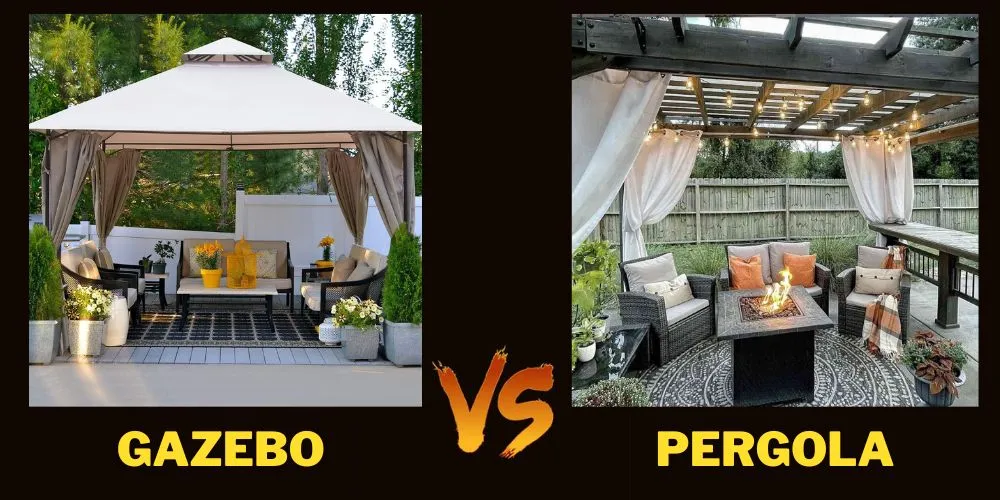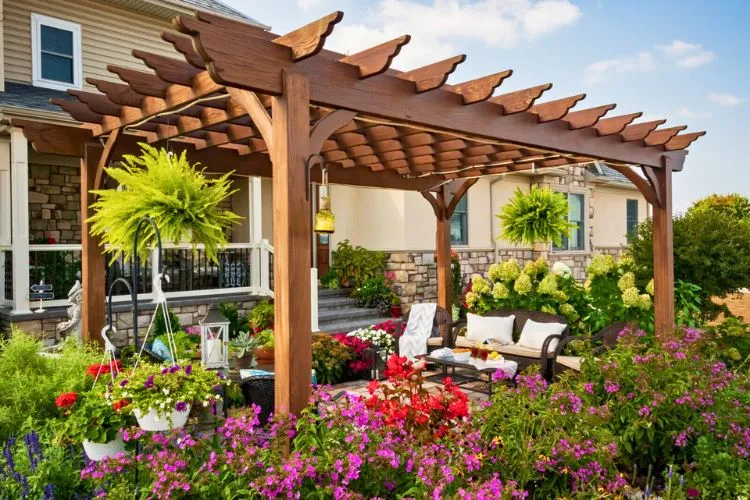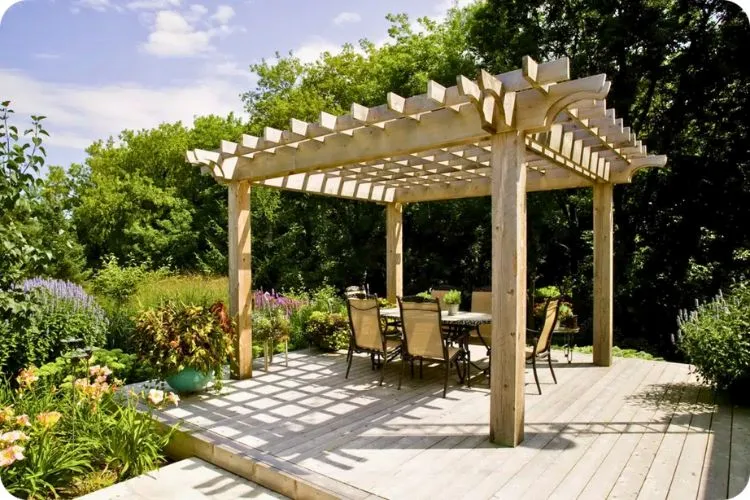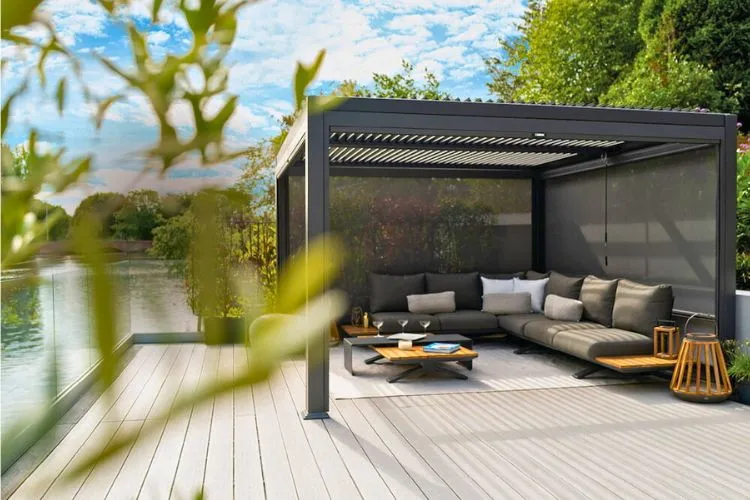Outdoor living spaces serve as tranquil retreats in the comfort of our homes. Among various structures to enhance these areas, gazebos and pergolas stand out for their beauty and functionality.
This article delves into the gazebo vs pergola differences, advantages, and considerations tied to each option, aiding homeowners in their decision-making process.

Contents
- 1 Understanding Gazebos and Pergolas
- 2 Gazebo vs Pergola: Functionality and Use Cases
- 3 Design and Aesthetics
- 4 Installation and Maintenance
- 5 Costs and Considerations
- 6 Pros and Cons
- 7 Choosing the Right Structure for Your Space
- 8 Pro Tips
- 9 Frequently Asked Questions (FAQs)
- 9.1 Can a pergola provide as much shade and privacy as a gazebo?
- 9.2 How long does it typically take to install a gazebo or pergola?
- 9.3 Are permits required for installing gazebos and pergolas?
- 9.4 Can gazebos or pergolas be freestanding, or do they need to be attached to a house?
- 9.5 What is the best material for a gazebo or pergola in a humid climate?
Understanding Gazebos and Pergolas
What is a Gazebo?
A gazebo is a freestanding, roofed structure often found in gardens and parks. Typically octagonal in shape, gazebos come equipped with a solid roof and an open or semi-open framework.
They’re constructed using materials such as wood, metal, or vinyl. Their raised floors and potential for built-in seating add to their charm, making them a cozy haven for relaxation and enjoyment.
What is a Pergola?
Pergolas, with their distinct architectural form, create shaded outdoor spaces through a network of vertical posts and an open lattice. While traditionally made of wood, modern versions also utilize metal and PVC.
Pergolas can either stand alone or adjoin buildings, enhancing pathways, patios, or gardens. Their structure supports climbing plants, eventually forming a natural canopy.
Gazebo vs Pergola: Functionality and Use Cases
Gazebos offer a level of shelter and privacy that suits various activities. They are ideal for dining areas, outdoor spas, or simply as serene spots to unwind within a garden’s embrace.
The enclosed or semi-enclosed design shields occupants from the elements more effectively than pergolas. Pergolas, in contrast, lend a lighter, more open feel to outdoor spaces.
They excel in creating charming walkways or patio covers where the interplay of light and shadow adds to the ambiance. The open-top structure is perfect for gardening enthusiasts looking to showcase climbing plants or vines.
Design and Aesthetics
Gazebo Design Considerations
Gazebos can range from simplistic to ornate designs, depending on personal taste and the home’s architectural style.

Popular customization options include the addition of screens, doors, or windows, enhancing their functionality across seasons. Gazebos often become the focal point of a garden, offering both visual appeal and practical shelter.
Pergola Design Considerations
Pergolas bring an element of classical elegance to outdoor spaces, favoring simplicity and natural beauty.
They offer versatile customization through the addition of retractable canopies, lighting, and decorations. These features not only boost a pergola’s utility but also its aesthetic harmony with its surroundings.
Installation and Maintenance
Gazebos and pergolas both demand consideration regarding installation and maintenance. While gazebos might require a more intensive setup due to their complexity, pergolas are generally seen as less demanding in terms of construction.
Maintenance primarily depends on the chosen material. Wood structures need regular treatment to fend off decay and pests, whereas metal and vinyl demand less upkeep but might not offer the same warm aesthetic.
Costs and Considerations
Choosing between a gazebo and a pergola often comes down to budget, space, and personal preference. Gazebos usually involve a higher initial investment, especially for custom designs or premium materials.

Pergolas can be more cost-effective, particularly if opting for a simpler, more open structure. It’s crucial to consider the available space, intended use, and local climate when deciding, as these factors significantly influence the satisfaction and longevity of the investment.
Pros and Cons
Gazebos
Pros
✅ Offer more privacy and protection from weather elements.
✅ Provide a distinct aesthetic appeal and cozy ambiance.
Cons
❌ Generally more expensive than pergolas.
❌ Might require building permits, increasing total costs and planning time.
Pergolas
Pros
✅ Blend naturally with the outdoor environment, supporting greenery.
✅ Typically less expensive, offering a cost-effective way to enhance outdoor spaces.
Cons
❌ Offer less shelter from rain and sun compared to gazebos.
❌ May require more maintenance, especially if constructed from wood.
You may also find useful: Marquee vs Gazebo
Choosing the Right Structure for Your Space
Determining whether a gazebo or pergola better suits your needs involves assessing several factors. Space availability, personal style preferences, and specific use cases all play a role in this decision.

For those seeking a more enclosed, private setting, a gazebo might be the way to go. Conversely, a pergola could be the perfect choice for garden lovers or those desiring a more open, airy outdoor area.
Consulting with landscape designers or outdoor living experts can provide valuable insights tailored to your situation.
Pro Tips
To maximize the potential of your outdoor space, think creatively about the integration of a gazebo or pergola. Consider the materials and design that will best withstand your climate and use.
Harmonizing the style of these structures with your home’s architecture ensures a cohesive and appealing outdoor environment.
Through thoughtful selection and placement, gazebos and pergolas can significantly elevate the beauty and functionality of your outdoor spaces.
Frequently Asked Questions (FAQs)
Can a pergola provide as much shade and privacy as a gazebo?
While pergolas offer a breezy, open canopy conducive to plant growth, they do not inherently provide as much shade or privacy as gazebos. However, additions like retractable canopies or climbing plants can increase their shade and privacy levels.
How long does it typically take to install a gazebo or pergola?
The installation time can vary based on the complexity of the design and material. Pergolas often require less time to install than gazebos due to their simpler structure.
Are permits required for installing gazebos and pergolas?
Permit requirements depend on local building codes and the structure’s size and design. It’s important to check with local authorities before starting your project.
Can gazebos or pergolas be freestanding, or do they need to be attached to a house?
Both structures can be designed as freestanding elements or attached to another structure, offering flexibility in placement and design.
What is the best material for a gazebo or pergola in a humid climate?
In humid climates, materials like cedar, redwood, or specially treated woods, as well as metal or vinyl, are advisable for their resistance to moisture and decay.
Conclusion:
Both gazebos and pergolas offer unique benefits and aesthetic appeal to outdoor living spaces. Whether you seek a private retreat or a serene garden canopy, understanding the differences, pros, and cons of each structure is crucial.
By considering your space, style, and functional needs, you can choose the option that best complements your home and enhances your outdoor enjoyment.

Sergio Gomes, a passionate advocate for outdoor living and the male voice behind Shades Authority. With years of experience, Sergio is your trusted source for expert insights on gazebos, pavilions, cabanas, pergolas, and all things outdoor shade solutions. Join him on a journey to transform your outdoor spaces into stunning, functional retreats
